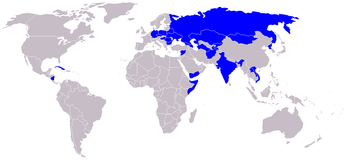Intersputnik
 Intersputnik logo | |
| Formation | 15 November 1971 |
|---|---|
| Legal status | Active |
| Headquarters | Moscow,Russia |
Membership | 25 member states |
Official language | Russian |
Director General | Ksenia Drozdova[1] |
| Website | intersputnik.int |
TheIntersputnik International Organization of Space Communications,commonly known asIntersputnik,is an internationalsatellitecommunications services organization founded on 15 November 1971, inMoscowby theSoviet Unionalong with a group of seven formerly socialist states (Poland,Czechoslovakia,East Germany,Hungary,Romania,Bulgaria,Mongolia) andCuba.
The objective was and continues to be the development and common use ofcommunications satellites.It was created as the Eastern Bloc's response to the WesternIntelsatorganization. As of 2008 the organization has 25 member states, among them theFederal Republic of Germanyas the legal successor of theGDR.
Intersputnik nowadays is a commercially aligned organization. It operates 12 satellites in orbit and 41transponders.In June 1997 Intersputnik created theLockheed Martin Intersputnik(LMI) joint venture together withLockheed Martin,which built and operated the satellites of the same name. In September 2006, Lockheed Martin Intersputnik was acquired byAsia Broadcast Satellite(ABS).
History
[edit]Initially, the Intersputnik system was created on the basis of the Soviet Orbit-2 satellite broadcasting network and was designed to serve the countries participating in theCouncil for Mutual Economic Assistance(Comecon). The main system and technical developments were carried out byNIIR,radio receiving equipment was produced at the Moscow Radio Engineering Plant, antenna-feeder devices at the Podolsk Electromechanical Plant, radio transmitting and channel-forming equipment was manufactured by the Krasnoyarsk TV Plant.
In the initial version, Intersputnik usedhighly elliptical satellitesof theMolniya-3type, and in 1978 it began usinggeostationary satellitesof theGorizonttype. Receiving complexes "Orbita-2" with transmitters "Gradient-K" and channel-forming equipment RS-1, RS-2 operated at the earth stations. In the process of modernization, the transmitters were replaced by more modern Helikon type with a power of 3 kW and new channel-forming equipment “Gradient-N” began to be used. Subsequently, theResearch Institute for Telecommunication(TKI) inBudapesttook part in the development of the equipment for Intersputnik, and factories inHungaryandCzechoslovakiawere connected to production.[2]
Member states
[edit] Afghanistan[3]
Afghanistan[3] Azerbaijan
Azerbaijan Belarus
Belarus Bulgaria
Bulgaria Cambodia
Cambodia Cuba
Cuba Czech Republic
Czech Republic Georgia
Georgia Hungary
Hungary India
India Kazakhstan
Kazakhstan Kyrgyzstan
Kyrgyzstan Laos
Laos Mongolia
Mongolia Nicaragua
Nicaragua North Korea
North Korea Poland
Poland Romania
Romania Russia
Russia Syria
Syria Tajikistan
Tajikistan Turkmenistan
Turkmenistan Ukraine
Ukraine Vietnam
Vietnam Yemen
Yemen

See also
[edit]- Ground stations
- Communications satellite
- Submarine communications cable
- European Telecommunications Satellite Organization
References
[edit]- ^"Directorate".Intersputnik.net.RetrievedMarch 4,2021.
- ^Vonog A. I.Intersputnik system.Krasnoyarsk TV plant.Our story. Retrieved March 4, 2021.
- ^"Member Countries".Intersputnik.Retrieved24 July2022.
External links
[edit]- Official website
- Agreement on the legal capacity, privileges and immunities,Berlin, 20 September 1976
- satnews.comArchived2007-07-11 at theWayback Machine
- english.pravda.ru
- un.org
- dlr.de
- Communications satellites
- Science and technology in the Soviet Union
- Space program of the Soviet Union
- Soviet and Russian space institutions
- Aerospace companies of the Soviet Union
- Foreign relations of the Soviet Union
- Eastern Bloc
- East Germany–Soviet Union relations
- Poland–Soviet Union relations
- Hungary–Soviet Union relations
- Czechoslovakia–Soviet Union relations
- Cuba–Soviet Union relations
- Romania–Soviet Union relations
- Soviet Union–Syria relations
- India–Soviet Union relations
- 1971 establishments in the Soviet Union
- Bulgaria–Soviet Union relations
- Communications in the Soviet Union
- Communications satellites of Russia
